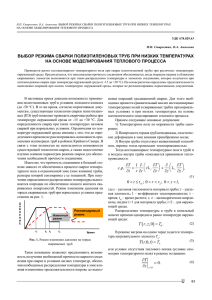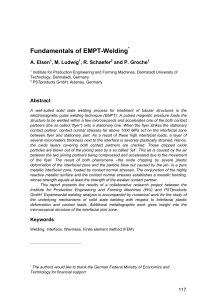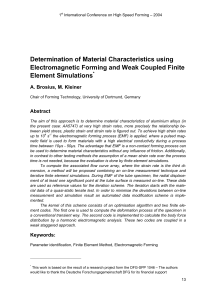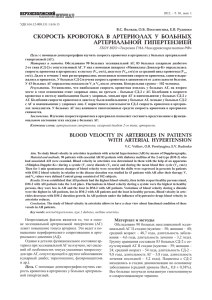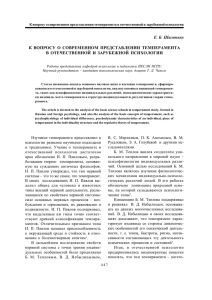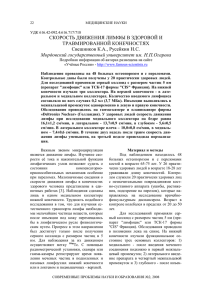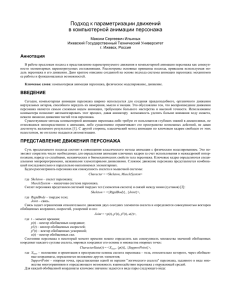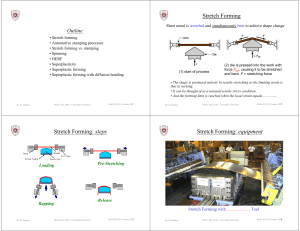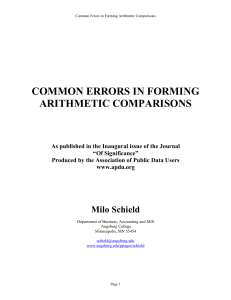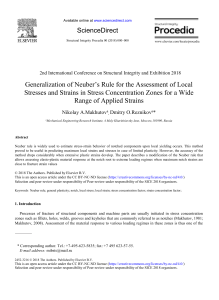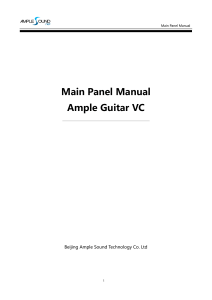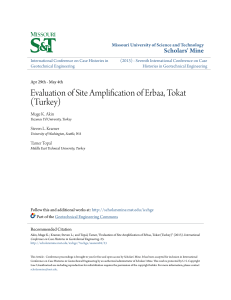Applications of Photon Doppler Velocimetry in Electromagnetic Forming
реклама
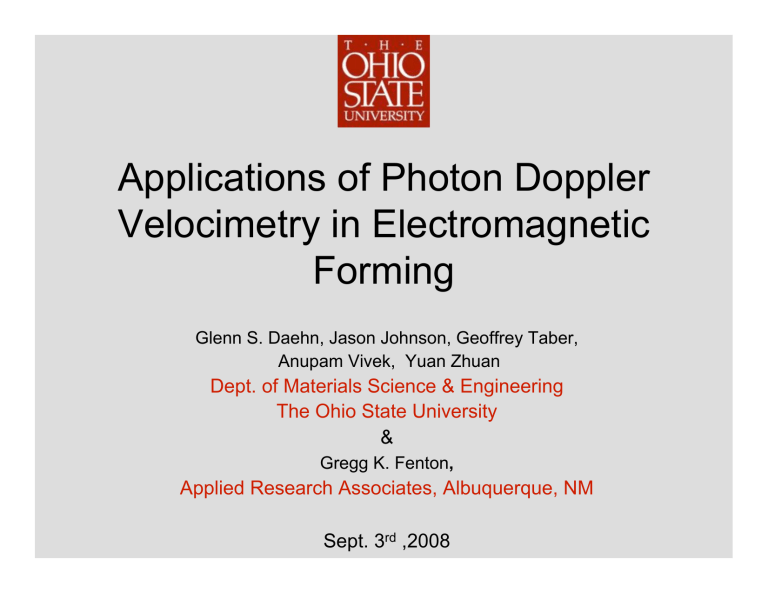
Applications of Photon Doppler Velocimetry in Electromagnetic Forming Glenn S. Daehn, Jason Johnson, Geoffrey Taber, Anupam Vivek, Yuan Zhuan Dept. of Materials Science & Engineering The Ohio State University & Gregg K. Fenton, Applied Research Associates, Albuquerque, NM Sept. 3rd ,2008 Photon Doppler Velocimetry Applied to Impulse Electromagnetic Forming •! Photon Doppler Velocimetry is an enabling technology for the advancement of EM forming as velocity is a key parameter in all applications. •! A heterodyne velocimetry system based on the work of Strand and others was constructed for 4 channels of velocity data at peak velocities under 1000 m/s. •! The system was used successfully to measure velocities of electromagnetically driven samples in a variety of experiments relating to electromagnetic forming and materials characterization. •! The methodology has contributed data useful in determining material properties under high strain rates and benchmarks for numerical analysis of EM forming. The system will be described and several applications shown Overview Motivating Applications Electromagnetic impulse driving of materials For characterization; ring expansion, powder compaction For forming; welding, die impact, crimping, spring back, shearing and others PDV System Major components, Technical details; power, reference levels, acquisition rates…. Experiments & Applications Materials characterization; Ring expansion, powder compaction Forming; Die impact, welding Motivating Applications Electromagnetic Forming (EMF) is a high rate forming process that offers advantages in agile manufacturing and studies of high strain rate & shock phenomena •! Currently, proper models are lacking for many high strain rate applications - Rapid transient nature of process makes characterization of parameters difficult •! PDV offers a relatively low cost method of monitoring velocity-time profiles for many geometries encountered in EMF - Such information can be used to benchmark material models and understand mechanistics of high rate deformation •! Develop constitutive relations for materials characterization - Stress-Strain-Strain rate relationships for bulk and powder materials - Ring expansion/compression •! Creates uniaxial stress state at high loading rates •! Possible to also employ high heating rates •! Stress and strain data can be calculated from velocity profile established with PDV Motivating Applications •! Ring expansion Quantify high strain rate materials properties Acceleration behavior of electromagnetically launched rings can be correlated to material flow stress Rings can be high or low conductivity (with driver technique) Repeatability and unambiguity of process is excellent, especially in comparison to Hopkinson bar experiments •! Impact welding Solid state welding process for similar and dissimilar materials Critical parameters: impact angle and velocity •! Die impact Inertial forming of sheet metal parts in one sided die Characterize strain rate and stresses in order to apply material failure models •! Powder compaction Momentum transfer from electromagnetically tube used to compact granular materials Motivating Applications Forming •! High strain rate deformation can produce hyperplasticity in ductile materials –! Strain rate sensitivity and inertial effects –! Fundamental mechanisms not fully understood •! Extended formability, reduced spring back •! Possible to form many materials in full hard condition •! Process characterization by PDV PDV Equipment •! NP Photonics 1 W erbium fiber laser –! 1550 nm with <3 kHz line width •! Fiber components –! Splitter, circulators, probes; JDS Uniphase & Oz Optics •! Newport Corp. 1 GHz photo detector 818BB •! LeCroy 1 GHz 4 channel Wavesurfer oscilloscope –! Up to 5 GS/s data acquisition rate •! With 10k/500k/2.5 M samples this is 2ms capture time Windows based system – data processing software –! MatLab, Mathematica, Excel PDV Equipment •! Data acquisition is triggered by a Rogowski probe –! Also provides current trace from capacitor bank •! Data from photodectors is recorded on 1 or more channels –! 1 GHz detectors allow measurements up to 775 m/s •! Data processing currently on desktop PC, soon directly on oscilloscope PDV Equipment •! Various probes –! Collimators & Focusors mostly Oz Optics –! Inside diameter periscopic adaptor •! Temperature data Digital IR thermometer Powder Powder compaction Coil for 19mm tube compression biaxial CF weave, PDV port Another compression coil uniaxial CF fiber with PDV port Samples 17 thru 22 17 empty 18-21 sand 21 sectioned - note retained sand 22 Tungsten Carbide Powder compaction study sample tubes 23 & 27 evacuated Velocity of tube wall Sand compacted in air Sand compacted at 3 Torr 60 50 40 30 20 10 0 1 6 11 16 21 26 31 36 41 46 51 56 61 66 71 76 81 86 91 96 101 106 111 116 121 Meters per second 70 microseconds Buckling; modes & mechanisms Buckling study samples Periscope probe for tube i.d. Welded region 4.8kJ 5.6kJ 6.4kJ 7.2 kJ As received As-received 4.8kJ 5.6kJ 6.4kJ 7.2kJ Welded region Trials on Dissimilar Welding Al-Cu Mg-Al Preparation for Microscope Studies 1 2 3 4 5 6 EM Welded Plates Mounted Sample on Cross-section of Six Machine Cut Pieces 40 Concluding Remarks • Much potential remains in high velocity forming. •! Velocity is the key design parameter. •! The Photon Doppler Velocimeter (PDV) makes these measurements much easier. , s d r a g e R t s Be hn e a D Glenn
